Experimental and Numerical Investigations of Hydraulics in Water Intake with Stop-Log Gate
Abstract
1. Introduction
2. Methodology
2.1. Theoretical Considerations
2.2. Numerical Simulation
2.2.1. Governing Equations
2.2.2. Model Setup
2.3. Experimental Tests
3. Results and Discussions
3.1. Comparisons Between Measurements and Simulations
3.2. Flow Regime
3.3. Head Loss
3.4. Flow Velocity at Trash Rack
3.4.1. Flow Velocity Distribution
3.4.2. Maximum Velocity
3.4.3. Position of the Maximum Velocity
4. Conclusions
- (1)
- At the water intake, flow regime changes dramatically after the employment of stop-log gate; the occurrence of flow recirculation and vortices in the intake chamber is affected considerably by the water head and the intake geometry.
- (2)
- Head loss at the intake depends significantly on the upstream water head, width of intake chamber and withdrawal depth. Based on the regression analysis of systematical data, an empirical equation for the coefficient of head loss is derived; the calculated results from the equation show a good agreement with both experimental and numerical data from previous studies.
- (3)
- Flow velocity at the trash rack section varies vertically in a great manner. The velocity distribution coefficient is dependent exclusively on the relative intake depth, showing a range of 1.4–2.2 with different depths. Regardless of the different water head and the geometry of stop-log gate, the maximum flow velocity always occurs at roughly 1.05–1.30 times of the gate height.
Author Contributions
Funding
Acknowledgments
Conflicts of Interest
References
- Wang, S.; Qian, X.; Han, B.; Luo, L.; Hamilton, D.P. Effects of local climate and hydrological conditions on the thermal regime of a reservoir at Tropic of Cancer, in southern China. Water Res. 2012, 46, 2591–2604. [Google Scholar] [CrossRef]
- Carron, J.C.; Rajaram, H. Impact of variable reservoir releases on management of downstream water temperatures. Water Resour. Res. 2001, 37, 1733–1743. [Google Scholar] [CrossRef]
- Palancar, M.C.; Aragon, J.M.; Sanchez, F.; Gil, R. Effects of warm water inflows on the dispersion of pollutants in small reservoirs. J. Environ. Manag. 2006, 81, 210–222. [Google Scholar] [CrossRef] [PubMed]
- Sherman, B.; Todd, C.R.; Koehn, J.D.; Ryan, T. Modelling the impact and potential mitigation of cold water pollution on Murray cod populations downstream of Hume Dam Australia. River Res. Appl. 2007, 23, 377–389. [Google Scholar] [CrossRef]
- Thorpe, J.E. Life history responses of fishes to culture. J. Fish Boil. 2004, 65, 263–285. [Google Scholar] [CrossRef]
- Lian, J.; Li, P.; He, W.; Shao, N. Experimental and numerical study on the effect of the temperature-control curtain in thermal stratified reservoirs. Appl. Sci. 2019, 9, 5354. [Google Scholar] [CrossRef]
- Zhang, S.; Gao, X. Effects of selective withdrawal on temperature of water released of glen Canyon dam. In Proceedings of the 4th International Conference on Bioinformatics and Biomedical Engineering, Chengdu, China, 18–20 June 2010. [Google Scholar]
- Zheng, T.; Sun, S.; Liu, H.; Xia, Q.; Zong, Q. Optimal control of reservoir release temperature through selective withdrawal intake at hydropower dam. Water Sci. Tech. Water Suply 2017, 17, 279–299. [Google Scholar] [CrossRef][Green Version]
- He, W.; Lian, J.; Yao, Y.; Wu, M.; Ma, C. Modeling the effect of temperature-control curtain on the thermal structure in a deep stratified reservoir. J. Environ. Manag. 2017, 202, 106–116. [Google Scholar] [CrossRef]
- Freckleton, D.R.; Johnson, M.C.; Boyd, M.L.; Mortensen, D.G. Stop logs for emergency spillway gate dewatering. J. Hydraul. Eng. 2011, 137, 644–650. [Google Scholar] [CrossRef]
- Wu, S.; Cao, W.; Wang, H.; Sun, S.; Chen, Q. Research on the multi-level intake water temperature effect of the Yalong River Jinping-I hydropower project. Sci. China Technol. Sci. 2011, 54, 125–132. [Google Scholar] [CrossRef][Green Version]
- Shifei, T. Analysis of the operation of stratified water intake for laminated beam gate of Guangzhao Hydropower Station. Guizhou Water Power 2011, 4, 18–21. [Google Scholar]
- Shamaa, Y.; Zhu, D.Z. Experimental study on selective withdrawal in a two-layer reservoir using a temperature-control curtain. J. Hydraul. Eng. 2010, 136, 234–246. [Google Scholar] [CrossRef]
- Rheinheimer, D.E.; Null, S.E.; Lund, J.R. Optimizing selective withdrawal from reservoirs to manage downstream temperatures with climate warming. J. Water Res. Plan. Manag. 2015, 141, 04014063. [Google Scholar] [CrossRef]
- He, W.; Lian, J.; Liu, F.; Ma, C.; Pan, S. Experimental and numerical study on the thrust of a water-retaining curtain. J. Hydroinform. 2018, 20, 316–331. [Google Scholar] [CrossRef]
- Zhang, L.; Zhang, J.; Peng, Y.; Pan, J.; Peng, Z. Numerical simulation of flow and temperature fields in a deep stratified reservoir using water-separating curtain. Int. J. Envron. Res. Public Health 2019, 16, 5143. [Google Scholar] [CrossRef]
- Vermeyen, T.B. Glen canyon dam multi-level intake structure hydraulic model study. In Water Resources Services, Water Resources Research Laboratory; Technical Service Center: Denver, CO, USA, 1999. [Google Scholar]
- Vermeyen, T.B. An overview of the design concept and hydraulic modeling of the glen canyon dam multi-level intake structure. In Proceedings of the Waterpower 99 Conference, Las Vegas, NV, USA, 6–9 July, 1999. [Google Scholar]
- Zhang, X.; Wang, X. Intake model test for Bakun hydropower project in Malaysiz. Northwest Hydropower 2005, 2, 59–62. [Google Scholar]
- Duan, W.; Huang, G.; Hou, D.; Du, L.; Liu, H. Hydraulic characteristics study on stoplog gates multi-level water intake of large hydropower station. J. Hydroelectr. Eng. 2015, 13, 380–384. [Google Scholar]
- Zhang, J.; Zhang, D.; Wu, Y.; Zhang, W.; You, X. Experimental study on hydraulic characteristics of the stratified intake for the fist-stage Jinping hydropower station. J. Hydroelectr. Eng. 2010, 29, 2–6. [Google Scholar]
- Lei, Y. Research on Numerical Simulation of Turbulent Flow for Stratified Intake in Hydropower Station. Ph.D. Thesis, Wuhan University, Wuhan, China, 2010. [Google Scholar]
- Li, Y.; Gao, X.; Xu, M.; Dong, S.; Zhang, Z.; Liu, X. Study on numerical simulation of hydraulic characteristics of intake for hydropower station. Water Resour. Hydropower Eng. 2010, 41, 29–32. [Google Scholar]
- Peng, X. Numerical Study on Hydraulic Characteristic of Multi-Level Intakes of Hydropower Stations. Ph.D. Thesis, Tianjin University, Tianjin, China, 2013. [Google Scholar]
- Du, L.; Xu, X. Numerical simulation research on the flow field in multi-level intake with stop-log gates of hydropower stations. China Rural Water Hydropower 2013, 8, 158–165. [Google Scholar]
- Zhang, Q. The Hydraulic Characteristics Numerical Simulation Study of Water Intake in the Water Inlet of the Hydropower Station. Master’s Thesis, Hebei University of Engineering, Handan, China, 2018. [Google Scholar]
- ANSYS, Inc. ANSYS Fluent User’s Guide; Release 17.2; ANSYS, Inc.: Southpointe, FL, USA, 2016. [Google Scholar]
- Hirt, C.W.; Nichols, B.D. Volume of fluid (VOF) method for the dynamics of free boundaries. J. Comput. Phys. 1981, 39, 201–225. [Google Scholar] [CrossRef]
- Jothiprakash, V.; Bhosekar, V.; Deolalikar, P.B. Flow characteristics of orifice spillway aerator: Numerical model studies. ISH J. Hydraul. Eng. 2015, 21, 216–230. [Google Scholar] [CrossRef]
- Teng, P.H.; Yang, J.; Pfister, M. Studies of two-phase flow at a chute aerator with experiments and CFD modelling. Model. Simul. Eng. 2016, 2016, 4729128. [Google Scholar] [CrossRef]
- Zhang, J.; Chen, J.; Xu, W. Three-dimensional numerical simulation of aerated flows downstream sudden fall aerator expansion-in a tunnel. J. Hydrodyn. 2011, 23, 71–80. [Google Scholar] [CrossRef]
- Yang, J.; Teng, P.H.; Zhang, H.W. Experiments and CFD modeling of high-velocity two-phase flows in a large chute aerator facility. Eng. Appl. Comput. Fluid Mech. 2019, 13, 48–66. [Google Scholar] [CrossRef]
- Shi, Q.S. High-Velocity Aerated Flow; Water & Power Press: Beijing, China, 2007. [Google Scholar]
- Heller, V. Scale effects in physical hydraulic engineering models. J. Hydraul. Res. 2011, 49, 293–306. [Google Scholar] [CrossRef]
- Hager, W.H. Wastewater Hydraulics: Theory and Practice, 2nd ed.; Springer: Berlin, Germany, 2010; pp. 29–33. [Google Scholar]
- Johnson, P.L. Hydro-power intake design considerations. J. Hydraul. Eng. 1998, 114, 651–661. [Google Scholar] [CrossRef]
- Liu, H.; Sun, S.; Zheng, T.; Li, G. Analysis on velocity distribution characteristics of trash rack for intake with stoplog gate of large-sized hydropower station. Water Resour. Hydropower Eng. 2018, 49, 89–96. [Google Scholar]

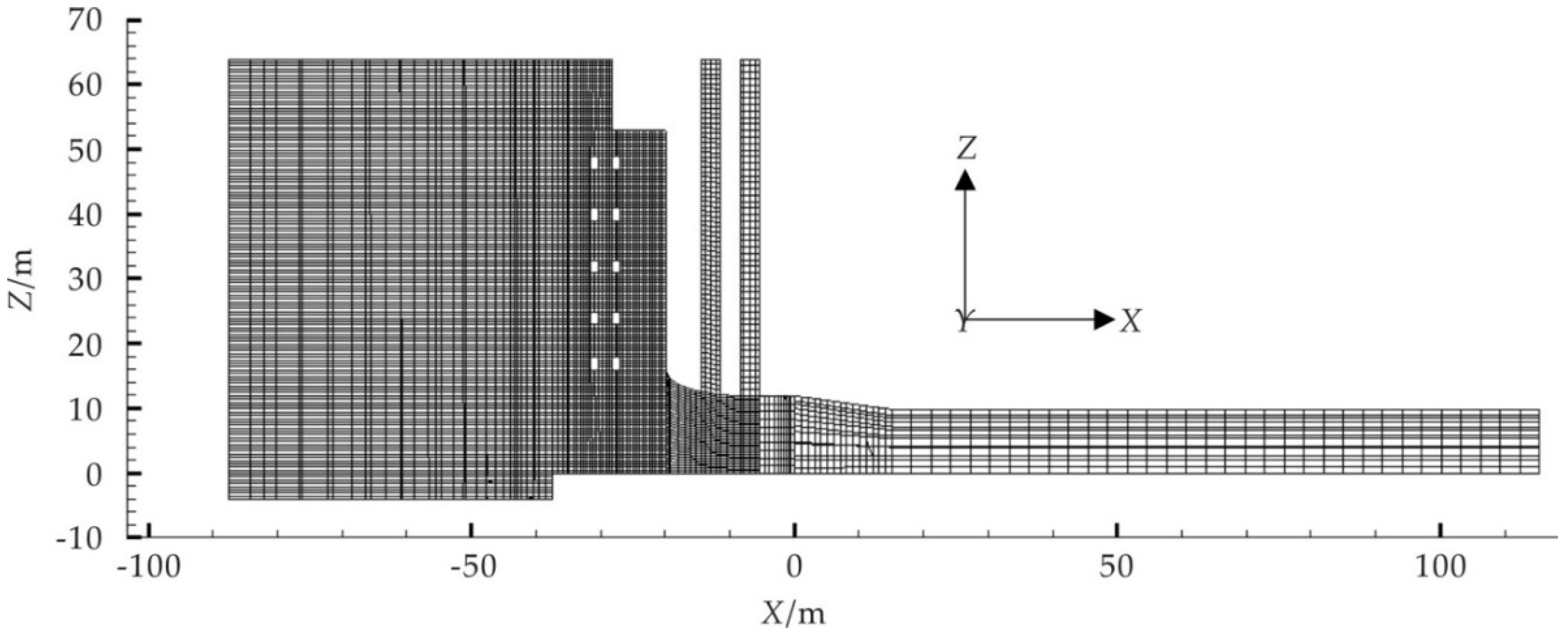

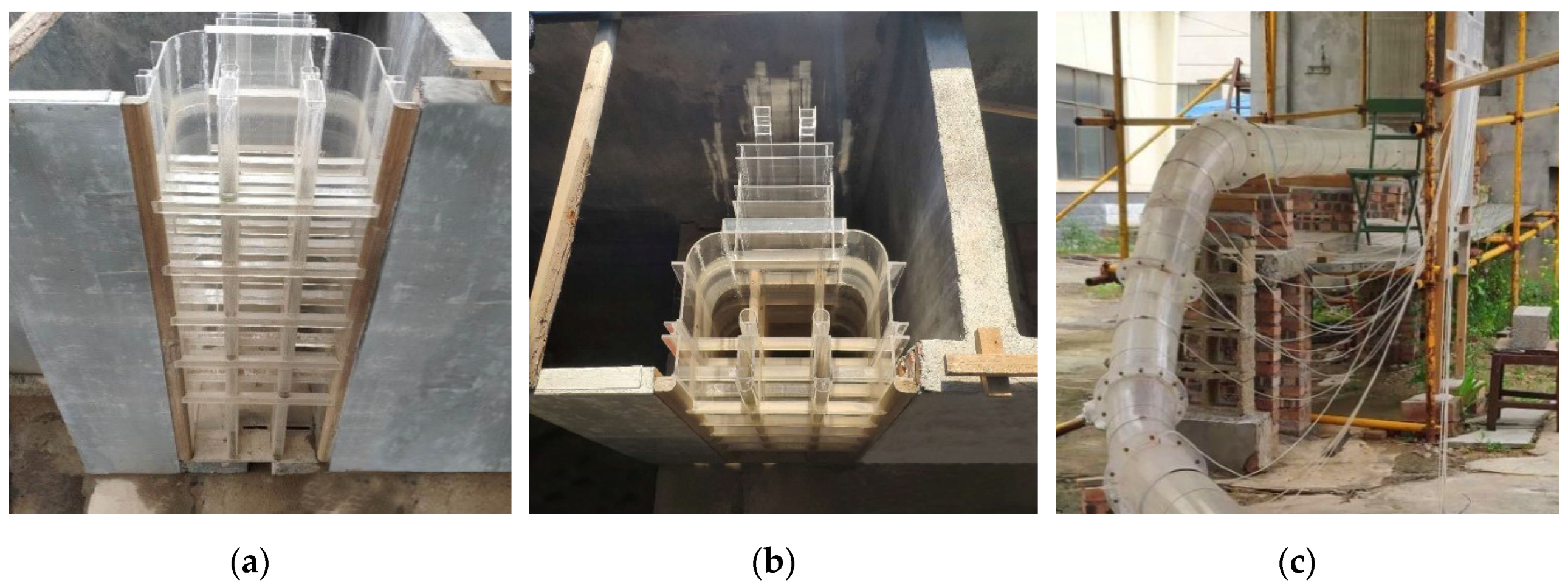
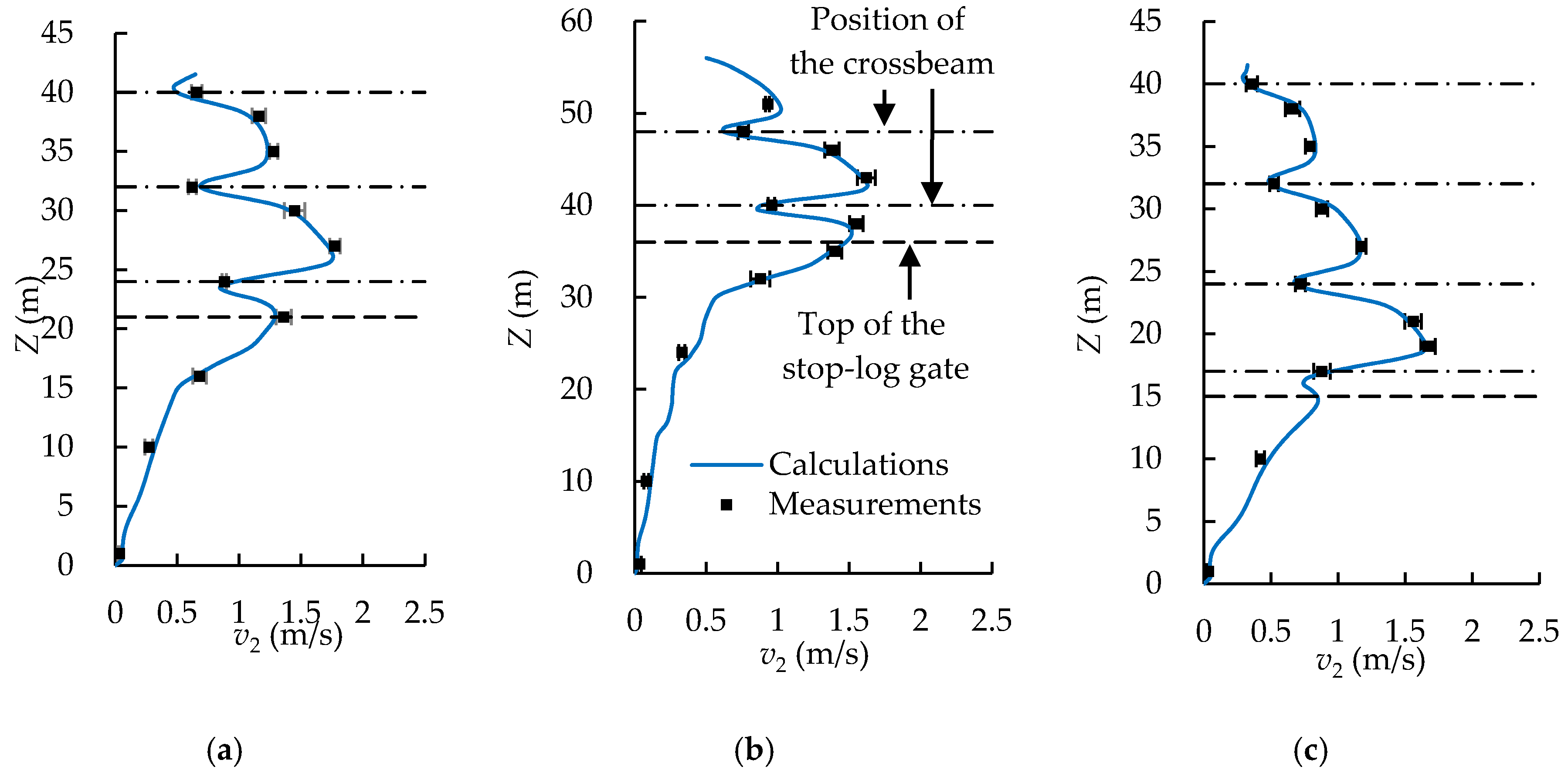

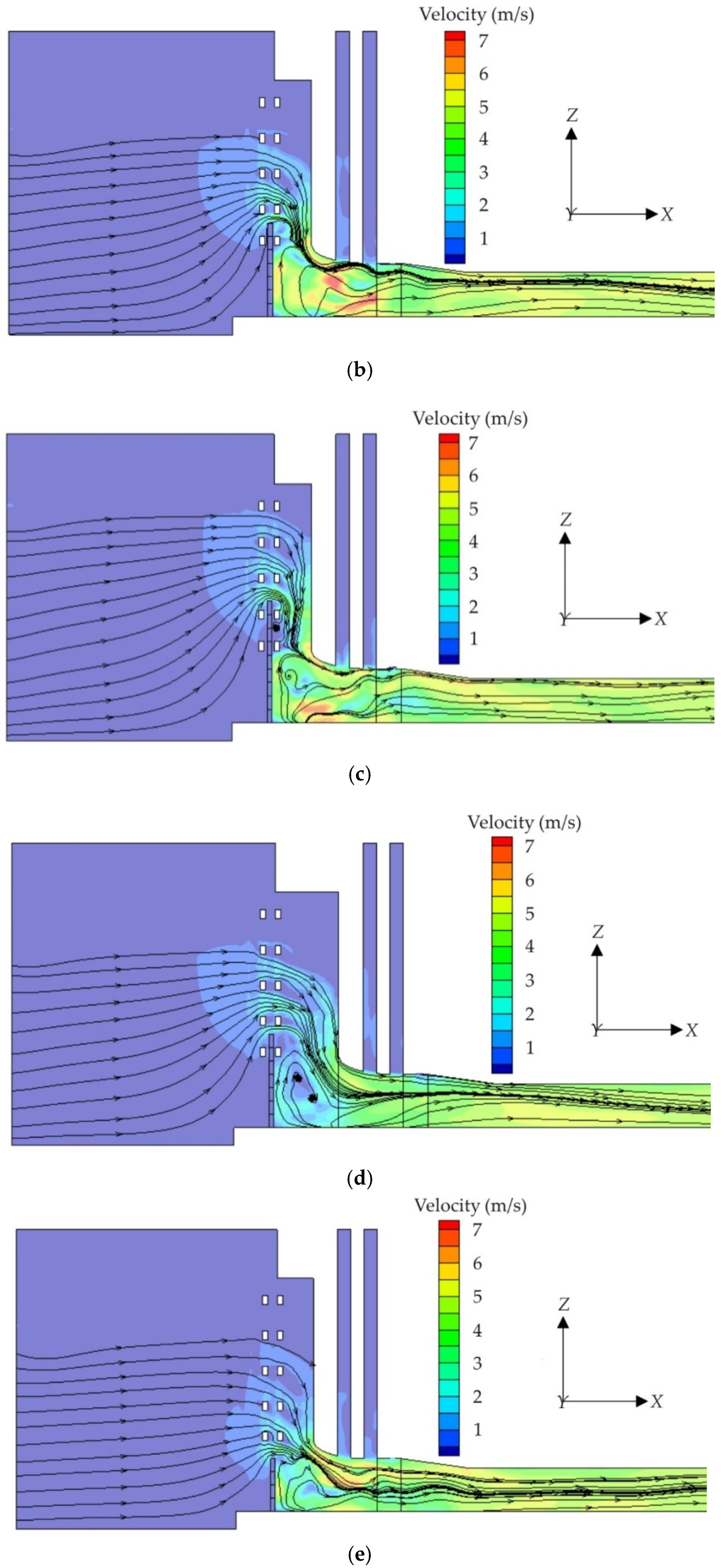

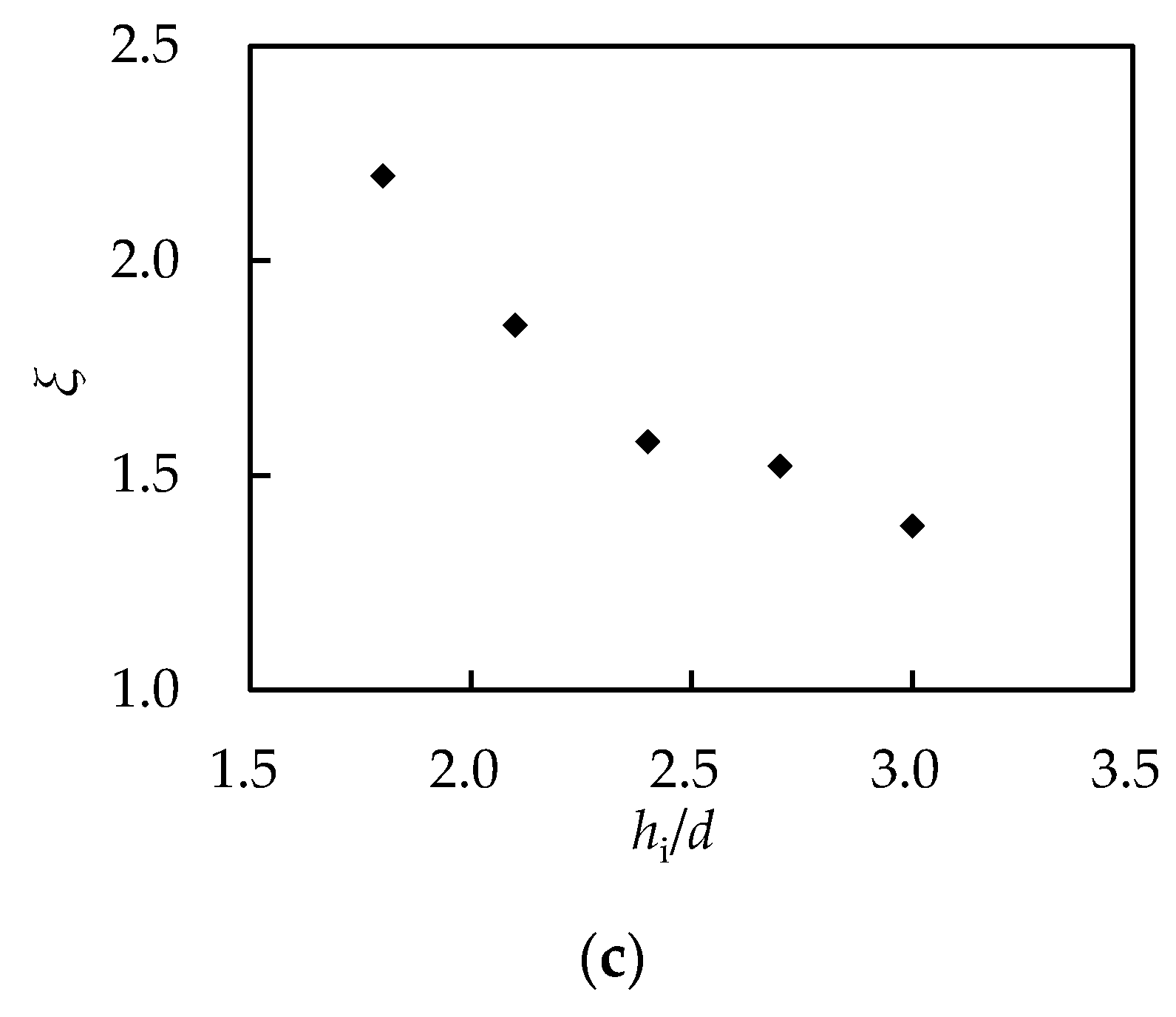


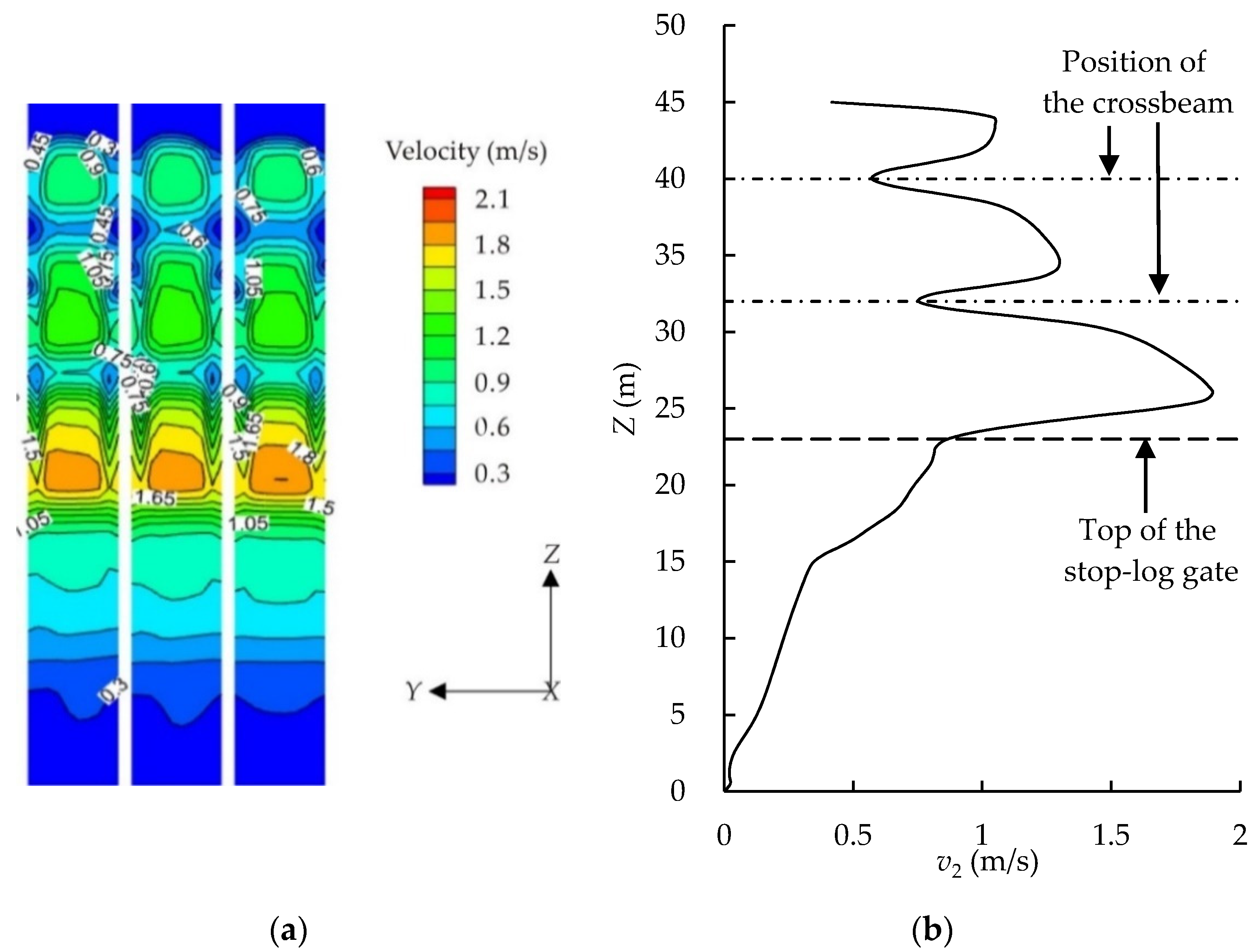


| Parameter | Cμ | C1ε | C2ε | σk | σε |
|---|---|---|---|---|---|
| Value | 0.09 | 1.44 | 1.92 | 1.00 | 1.30 |
| Cases | 1 | 2 | 3 | 4 | 5 | 6 | 7 | 8 | 9 | 10 | 11 | 12 | 13 | 14 | 15 | 16 | 17 | 18 |
|---|---|---|---|---|---|---|---|---|---|---|---|---|---|---|---|---|---|---|
| H (m) | 36 | 39 | 42 | 45 | 48 | 51 | 54 | 57 | 42 | 42 | 42 | 42 | 42 | 42 | 42 | 42 | 42 | 42 |
| l (m) | 7 | 7 | 7 | 7 | 7 | 7 | 7 | 7 | 8 | 9 | 10 | 11 | 13 | 15 | 7 | 7 | 7 | 7 |
| hi (m) | 21 | 21 | 21 | 21 | 21 | 21 | 21 | 21 | 21 | 21 | 21 | 21 | 21 | 21 | 18 | 24 | 27 | 30 |
| Case | Method | H (m) | p (m) | pv (m) | ΔH (m) | ξ |
|---|---|---|---|---|---|---|
| 3 | Measurements | 42 | 38.673 | 1.138 | 2.189 | 1.91 |
| Simulations | 42 | 38.654 | 1.221 | 2.125 | 1.85 | |
| 8 | Measurements | 57 | 53.289 | 1.210 | 2.501 | 2.17 |
| Simulations | 57 | 53.392 | 1.277 | 2.331 | 2.03 | |
| 17 | Measurements | 42 | 39.121 | 1.192 | 1.687 | 1.47 |
| Simulations | 42 | 38.998 | 1.256 | 1.746 | 1.52 |
| Data Sources | H (m) | l (m) | hi (m) | d (m) | Method | ξ | Err (%) | |
|---|---|---|---|---|---|---|---|---|
| Previous | Calculated | |||||||
| [20] | 89.00 | 8.00 | 49 | 11 | exp. | 1.15 | 1.09 | 5.2 |
| [24] | 63.00 | 12.00 | 18 | 8.3 | exp. | 0.65 | 0.62 | 5.1 |
| 45.00 | 12.00 | 18 | 8.3 | 0.61 | 0.55 | 9.8 | ||
| 33.00 | 12.00 | 18 | 8.3 | 0.57 | 0.50 | 13.1 | ||
| [25] | 61.00 | 8.00 | 25 | 11 | exp. | 2.06 | 1.77 | 14.2 |
| 61.00 | 8.00 | 25 | 11 | num. | 1.96 | 1.77 | 9.8 | |
| [26] | 14.00 | 7.00 | 2 | 6.4 | num. | 5.13 | 4.73 | 7.9 |
© 2020 by the authors. Licensee MDPI, Basel, Switzerland. This article is an open access article distributed under the terms and conditions of the Creative Commons Attribution (CC BY) license (http://creativecommons.org/licenses/by/4.0/).
Share and Cite
Ren, W.; Wei, J.; Xie, Q.; Miao, B.; Wang, L. Experimental and Numerical Investigations of Hydraulics in Water Intake with Stop-Log Gate. Water 2020, 12, 1788. https://doi.org/10.3390/w12061788
Ren W, Wei J, Xie Q, Miao B, Wang L. Experimental and Numerical Investigations of Hydraulics in Water Intake with Stop-Log Gate. Water. 2020; 12(6):1788. https://doi.org/10.3390/w12061788
Chicago/Turabian StyleRen, Weichen, Jie Wei, Qiancheng Xie, Baoguang Miao, and Lijie Wang. 2020. "Experimental and Numerical Investigations of Hydraulics in Water Intake with Stop-Log Gate" Water 12, no. 6: 1788. https://doi.org/10.3390/w12061788
APA StyleRen, W., Wei, J., Xie, Q., Miao, B., & Wang, L. (2020). Experimental and Numerical Investigations of Hydraulics in Water Intake with Stop-Log Gate. Water, 12(6), 1788. https://doi.org/10.3390/w12061788





